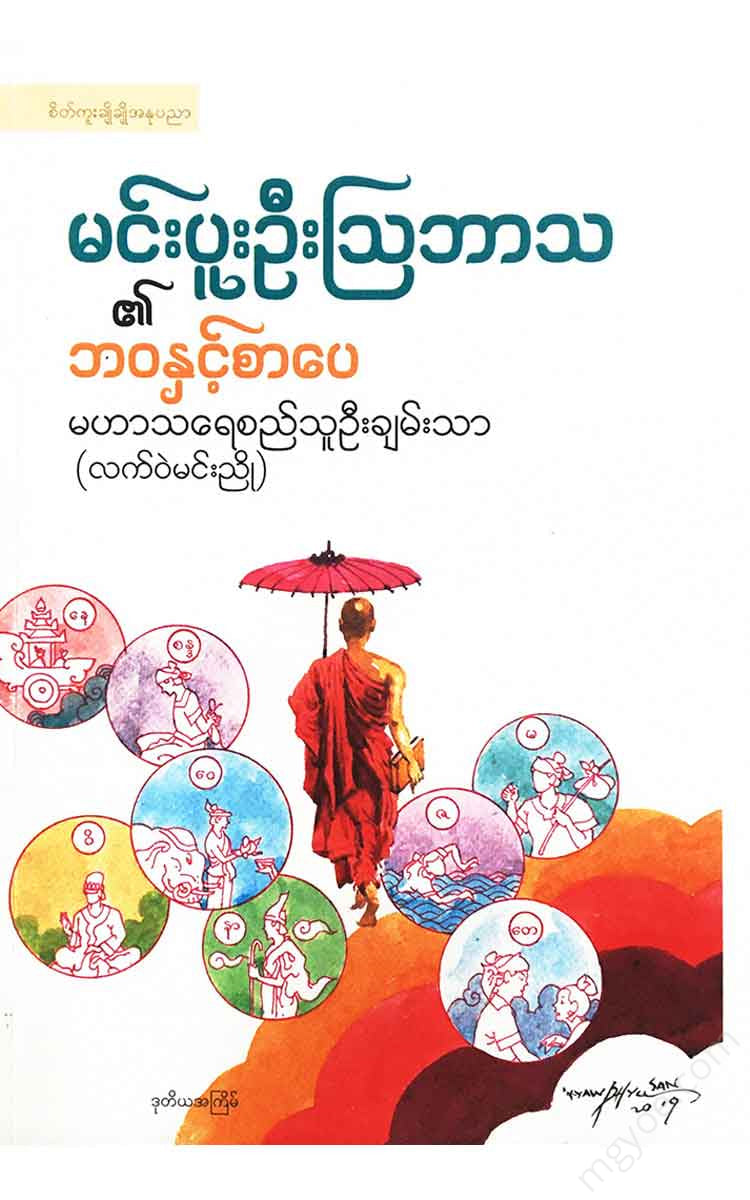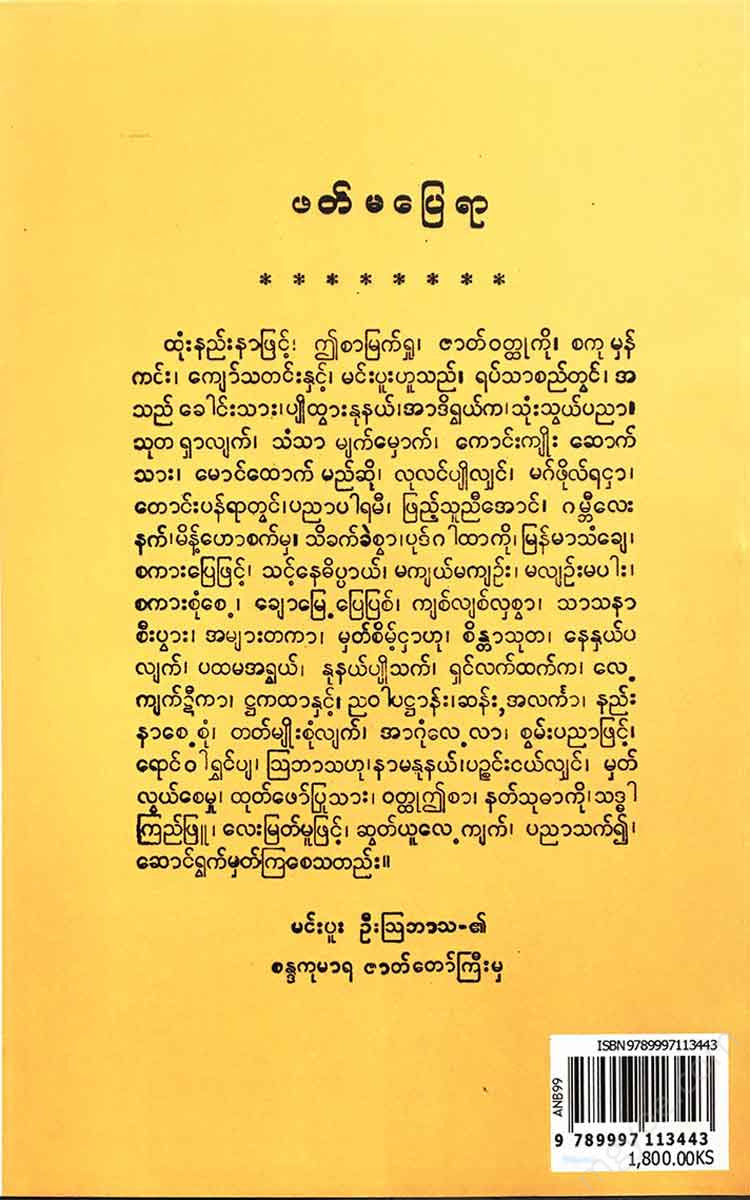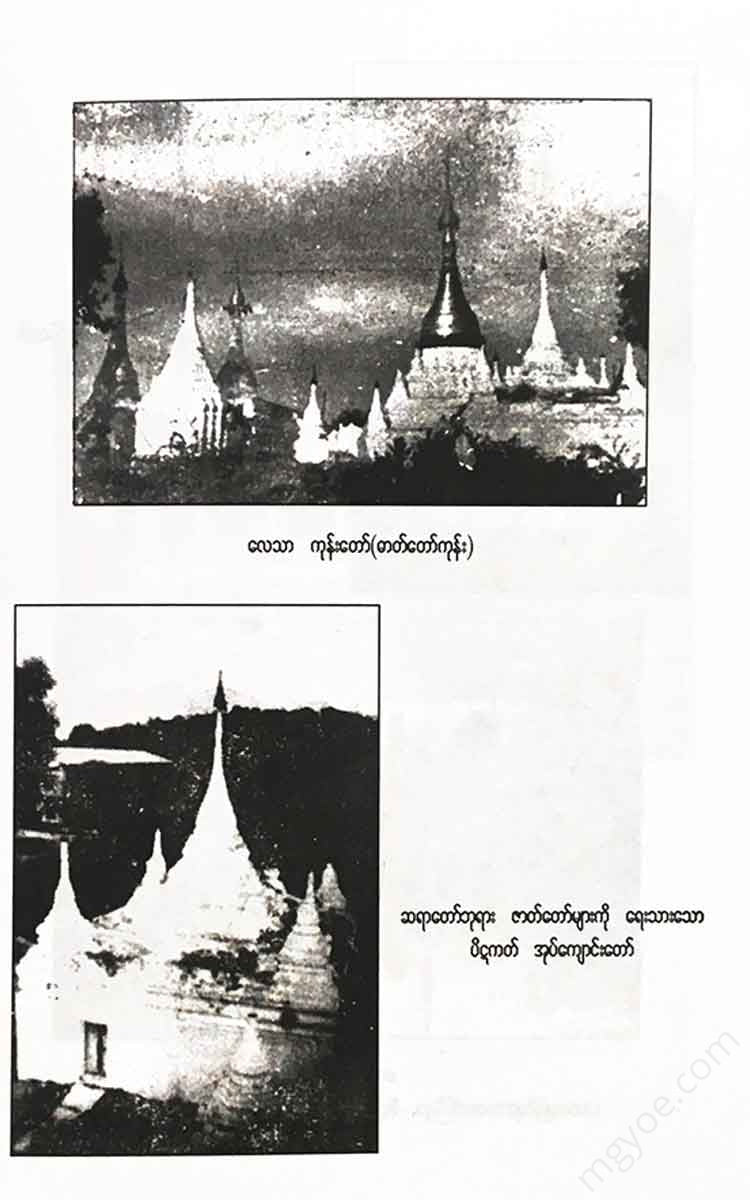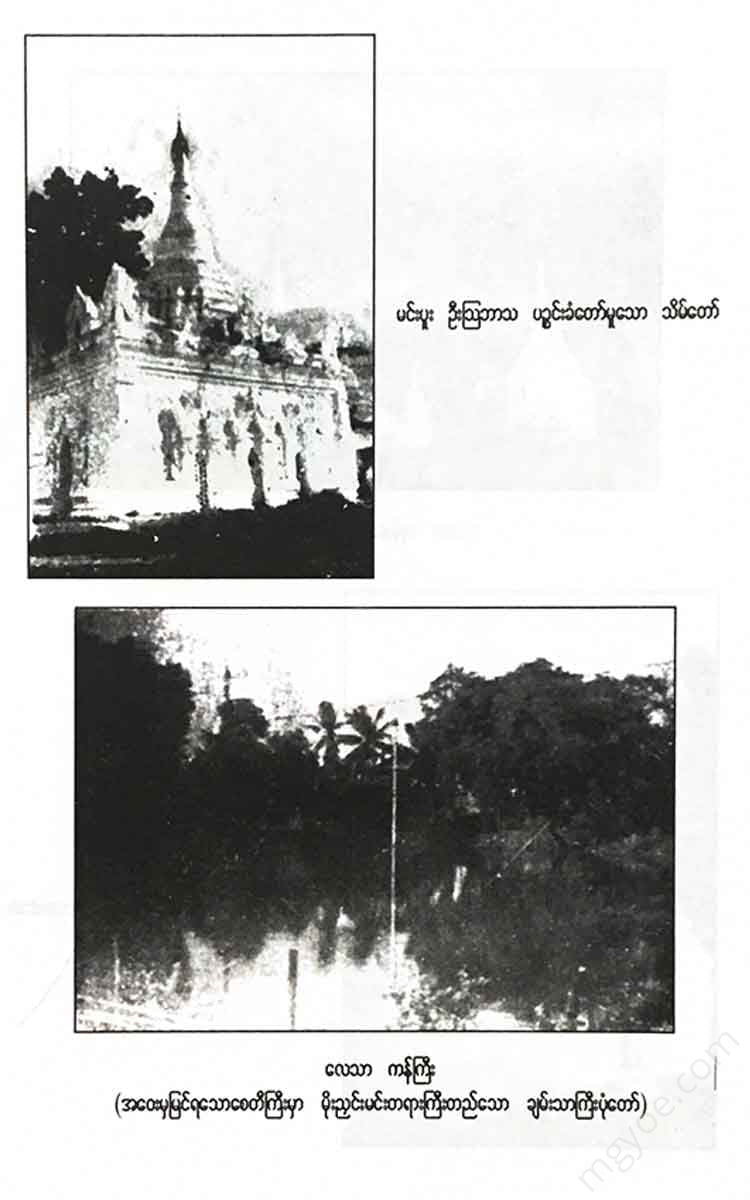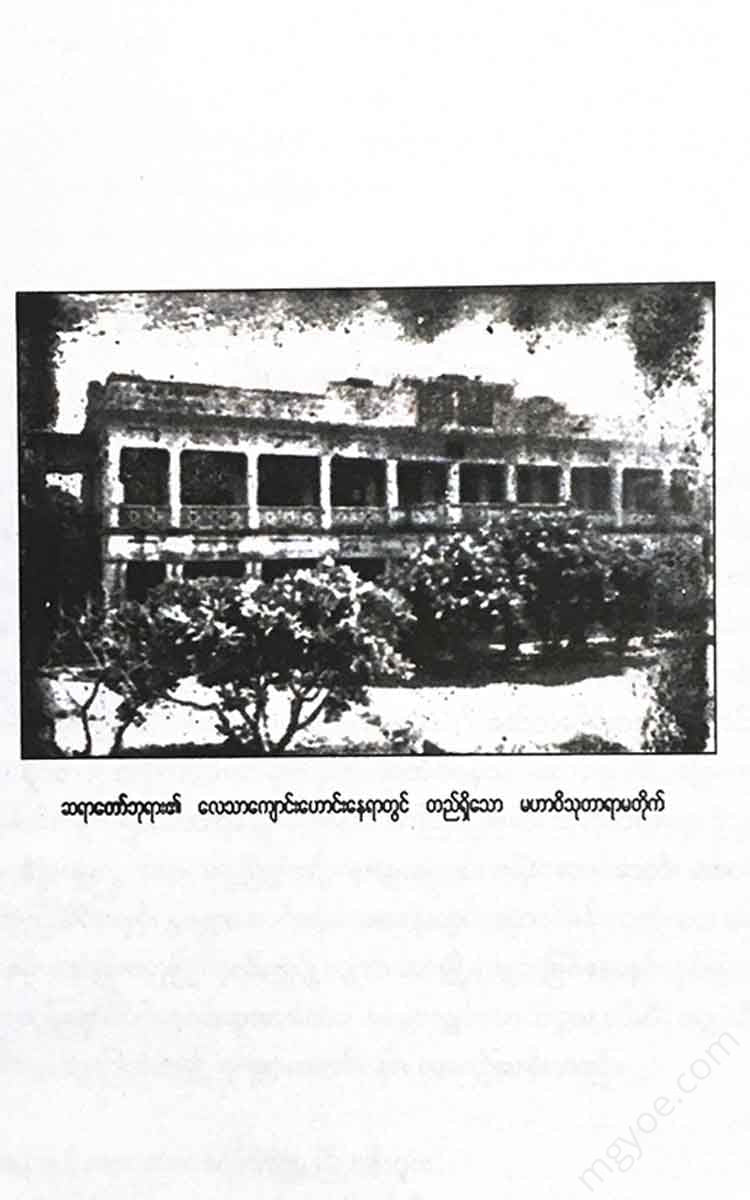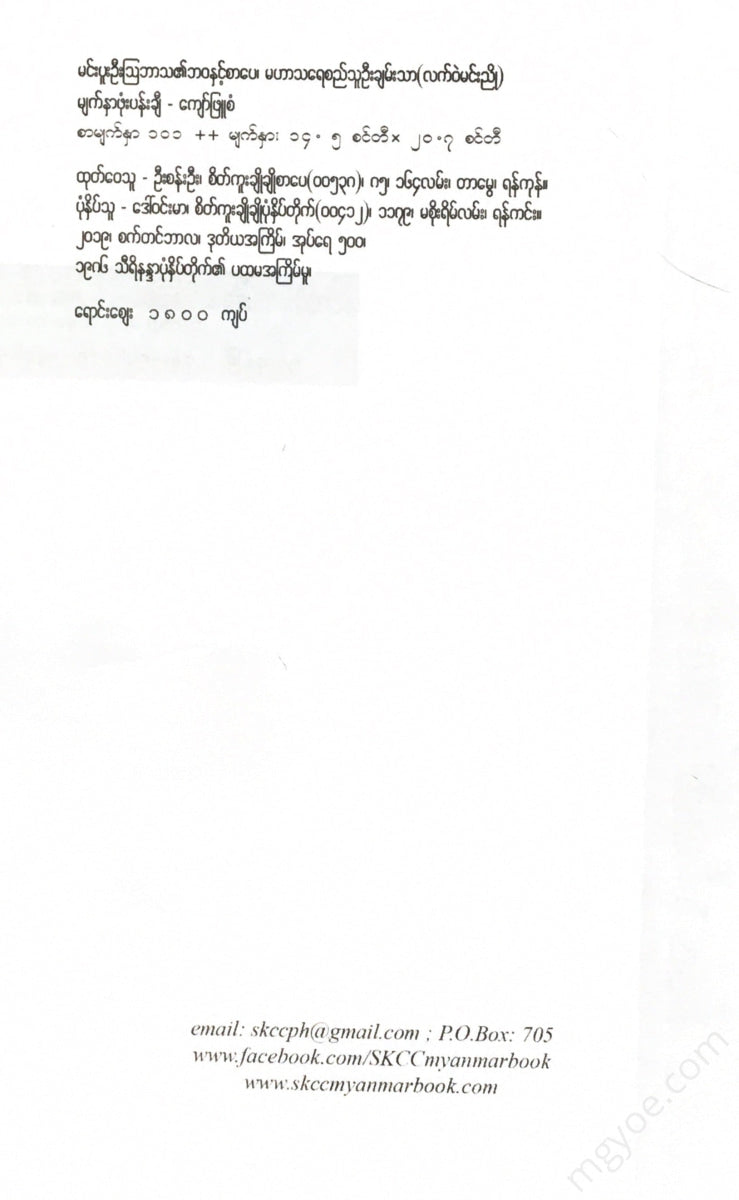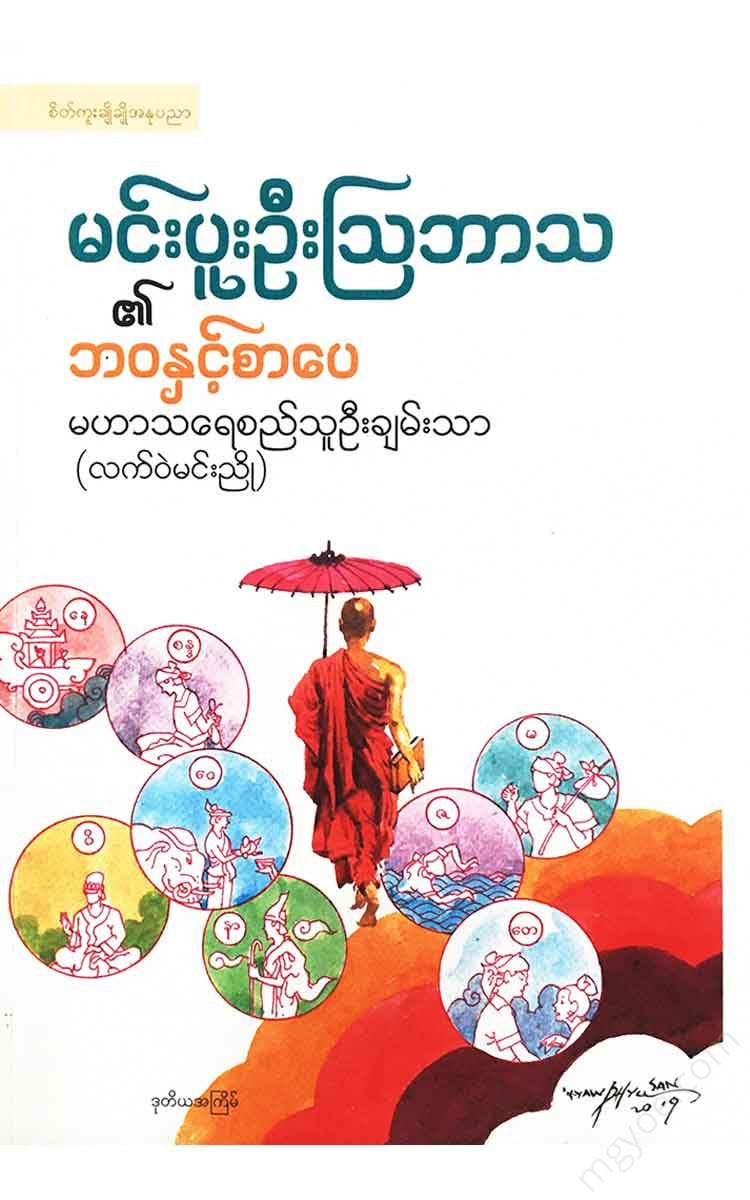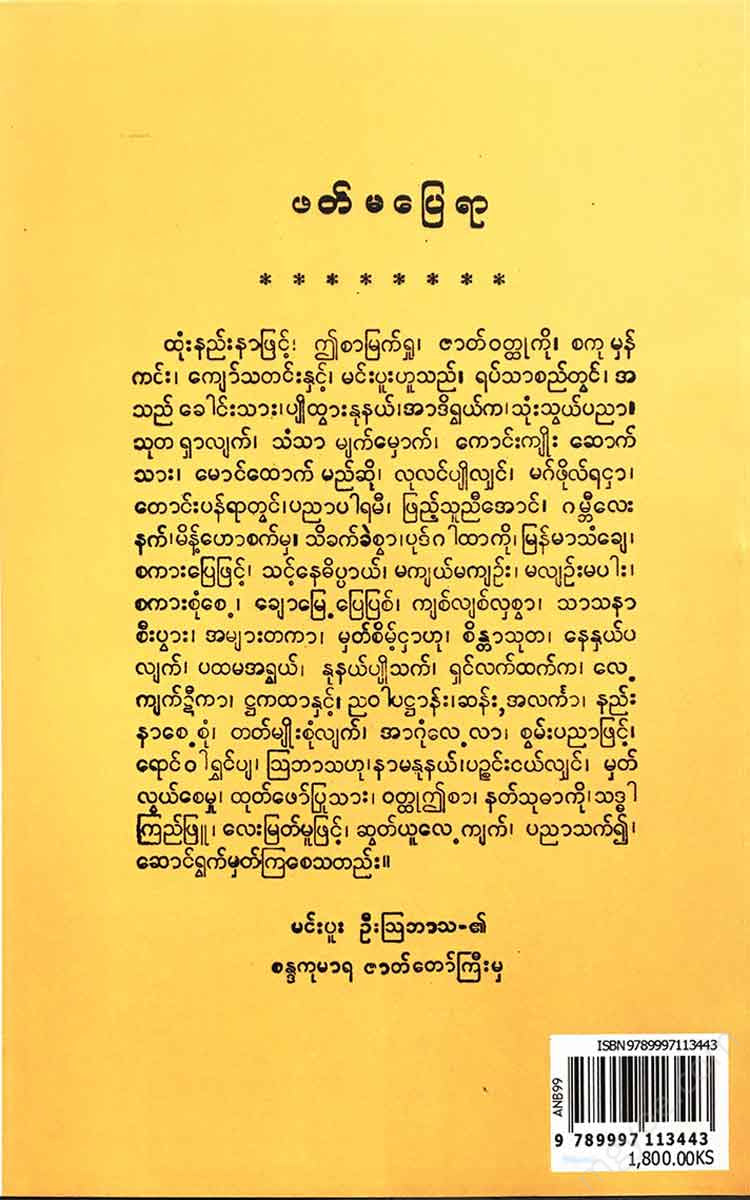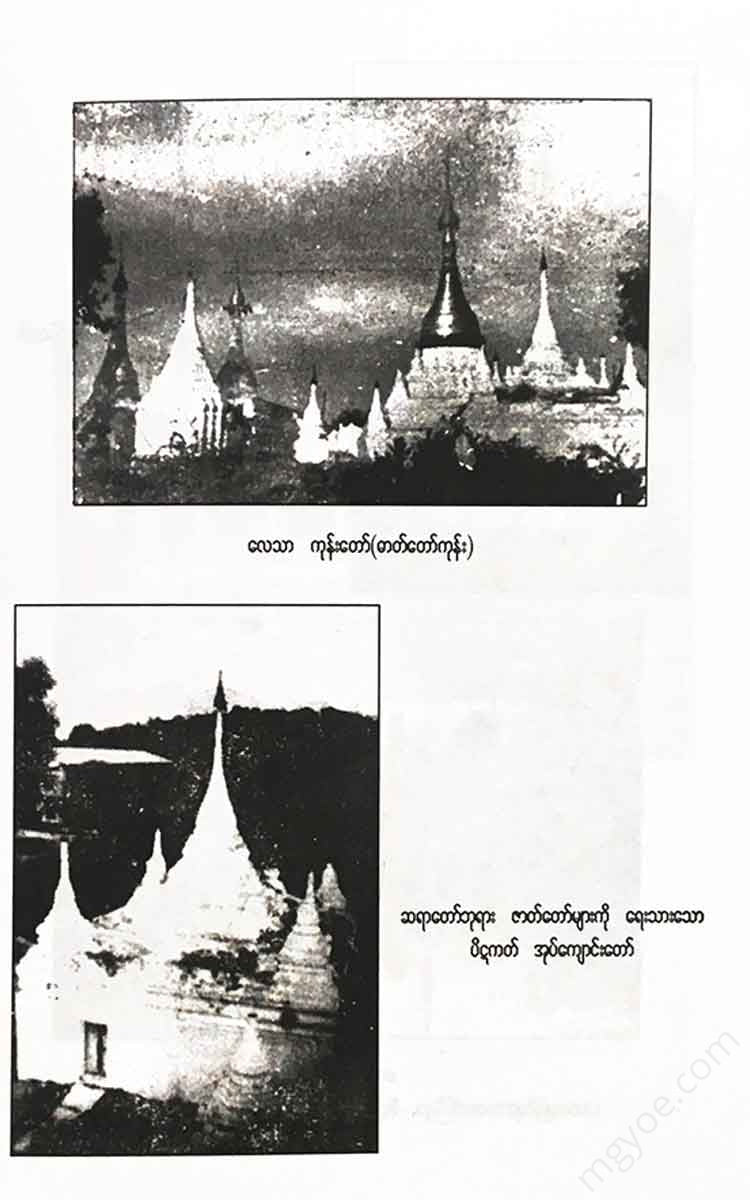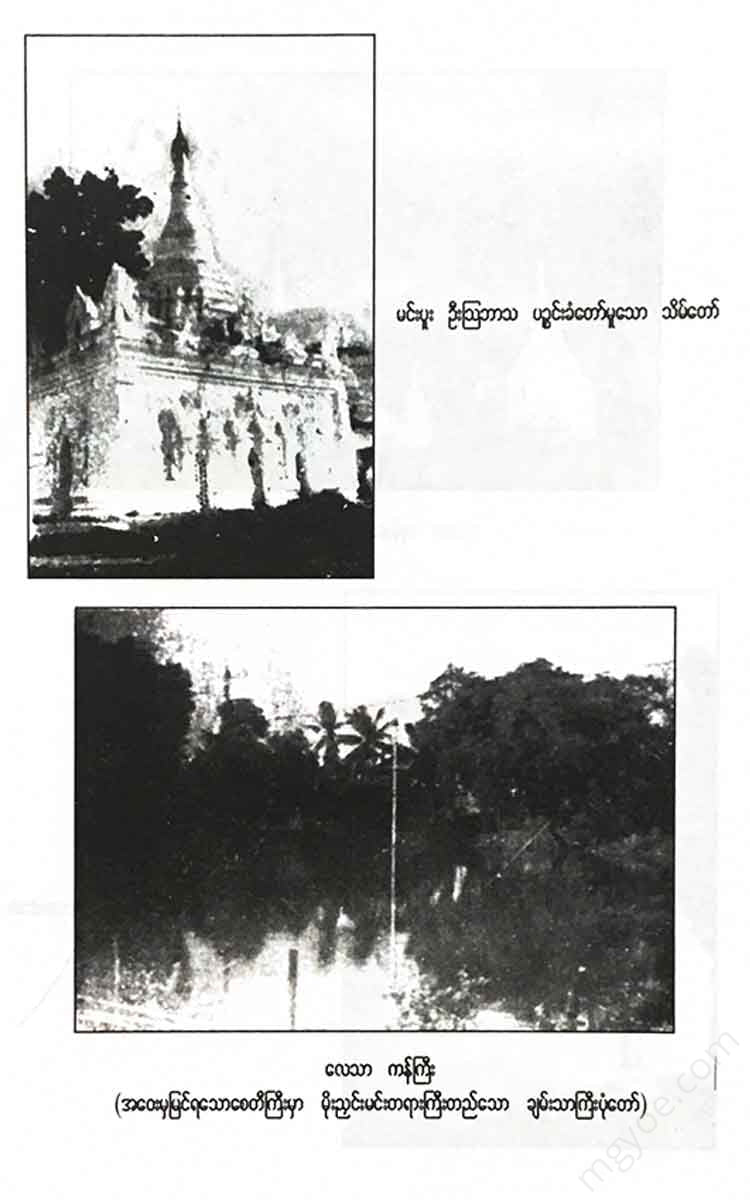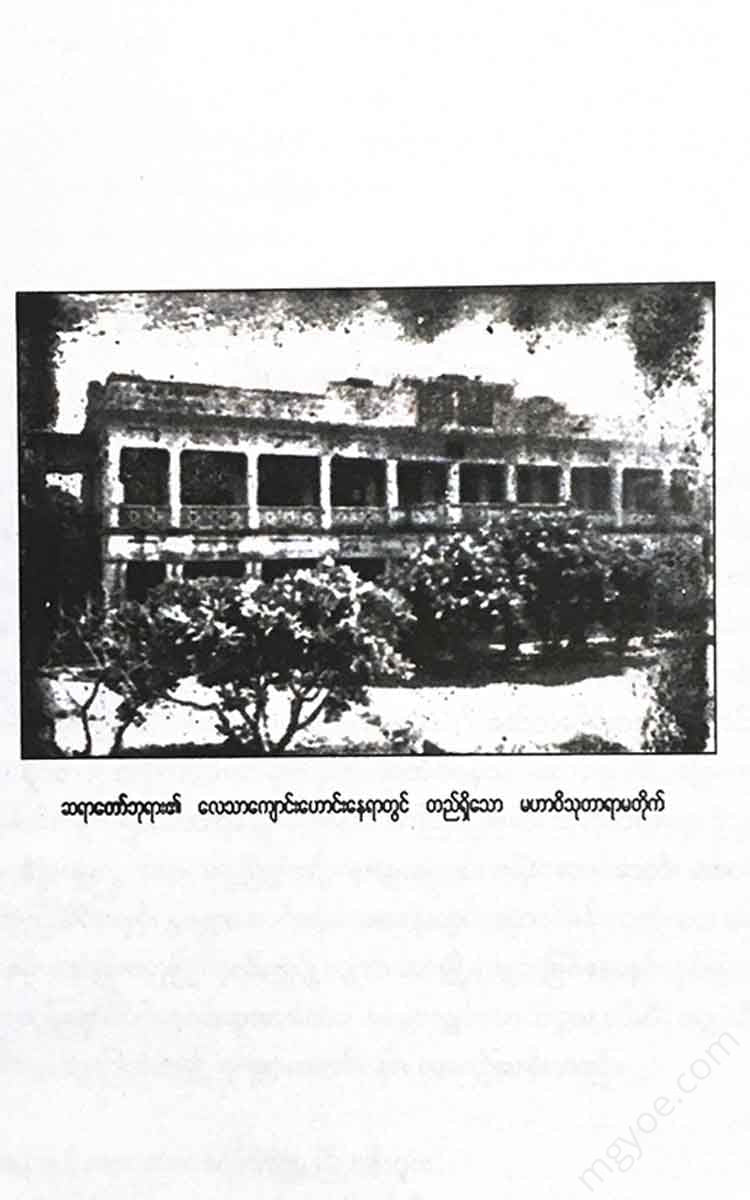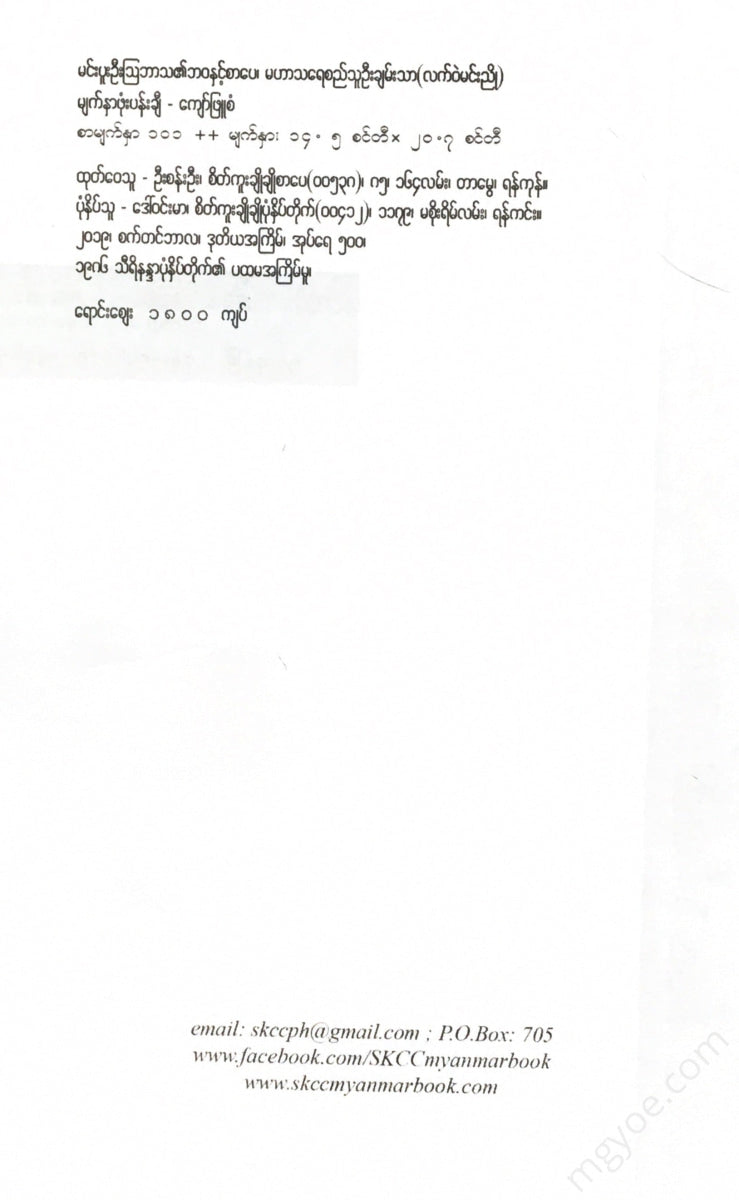စိတ်ကူးချိုချိုစာပေ
Maha Ashrai Sithu U Chanthan - The Life and Literature of Min Pu U Obatha
Maha Ashrai Sithu U Chanthan - The Life and Literature of Min Pu U Obatha
Couldn't load pickup availability
1. Namanta, from the river, the river flows, the two sables, the sables, the flowers, the beautiful, they meet, then they shine, the glory is shining, the Ganges River, Namanta, the six-faced monk, the nine-faced monk, the six-faced monk, in the local script, five hundred pearls, flying, the high-pitched monk, the memorial of May Tsenaung, to be worshipped, the Naga Namanta, with a request, one hundred and eight pieces of padasek, engraved in stone, engraved with a seal, on the top of the mountain, with a request. Five Maras, Myat Zika, set gold padas, feet down, two-fold, three bows to the Myathila, three times, three times, three six-pointed, bowed feet. Where the sun rises, towards the front, Namanta Maung, traveling, Aung Phyu Shin Hla, Si Ain Ma and Namanta Aung Mann, in the amazing, Taung Mann left, Myaung Maha Tung, one-sided city, spreading glory, Thanamanta, with the river, two-sided, beautiful, decorated with honor, Namanta, if Htet Ywa Nat Se, Mangki, equal in comparison, excellent, Namanta Aung Pan, beautiful and strange.
Mann and Eyar, meeting each other, Myo Mann Pu.
San Tint Tezar, Pong Ka Pwint Phu, Po Mann Oo.
Nan Myint Bwe Cha, Bon Tha Tin Htoo, Po Man Hnu.
2. In the temple, the Buddha offered prayers, the Buddha's name was Usha, the Buddha's name was Zina, the Buddha's name was Aka, when he came, he praised the temple as great, the Buddha's name was Tishavaya, the Buddha's name was Visupan, the temple was beautiful, the Buddha's name was Sandalwood, the deity's name was Indra In the era of the king, the king of the kingdom
San Tint Tezar, Pong Ka Pwint Phu, Po Mann Oo.
Nan Myint Bwe Cha, Bon Tha Tin Htoo, and Myo Man Hnu.
Mann and Eyar, meeting Karent Kyu, Myo Mann Pu.
3. Jayantar, from the palace of the great lord, in the care of, Suna Pran, from the flag of the kingdom, Namanta River, new glory, one thousand years, three hundred years, forty years, seven years, ten years, ten years, unparalleled, who brought, Namanta, religion, Myanmar + Myanmar. For the sake of benefit, because of serving, the king of gods, help, two hundred years, the anniversary has come, the sun is shining, in prose, in the realm of literature, unparalleled, shining, shining, shining, shining, from the balcony, eight books of poetry, "Samahaw", if it is a medicine, to a painting, to a statue, to a sculpture With 10 kinds of praise, with nine kinds of praise, full of wealth, six kinds of virtues, full of wisdom, a model under the sky, admirable, now that I have encountered it, in two years, my knowledge is bright, the "Life Literature of Buddhism" is published, preserved, and presented, full of praise, shining, shining, the front end of the Buddha, the giant, the back is a golden set, with eight hundred pieces, the north is bright, the north is dark, the Lianwin Monastery, the incense is fragrant, the mountain is salted, the earth is black, the sky is clear, the glory is high.
Nan Myint Bwe Cha, Bon Tha Tin Htoo, and Myo Man Hnu.
Mann and Eyar, meeting Karent Kyu, Myo Mann Pu.
San Tint Tezar, Pong Ka Pwint Phu, Po Mann Oo.
( a) Speechless
The Min Pu Association in Yangon unanimously decided to publish the life and literature of Min Pu U Sobhatha in commemoration of his 200th birthday and assigned the author to write and edit it. He accepted the assignment with great joy and honor and signed a contract to do so. I would like to first briefly explain the assignment and the reason for accepting the assignment. The author was born and raised in the same village of Min Pu U Sobhatha, which was the birthplace of Min Pu U Sobhatha about 80 years ago. He has been in contact with and has detailed knowledge of the surroundings of Min Pu U Sobhatha, such as Le Nya H Kone, Le Tha Kyaung, and Le Tha Kan for many years, and has personal knowledge of them. The great epics written in prose by Min Pu U Sobhatha are the Maha Janaka, Vaisantara, Maho Sa Da, which were selected by the ancient government as the best prose writings and recognized as school textbooks. Thanks to the teachings of Sayar U Tun Myaing and Sayar U Zin, who taught the four great epics of Tamiya in Burmese, he has studied them repeatedly and thoroughly, and has almost mastered them. First, he has passed eight historical subjects in his BA (Honours) and is suitable for research work. Second, Min Pu U Oo Ba Tha is a very prominent figure in the history of literature. Since the author is familiar with literature, it is considered that he is capable of criticizing U Oo Ba Tha's words and poems. Second, for these four reasons, the Min Pu Association unanimously gave the author this task, and the author happily accepted this honorable task.
I would like to add a little to the first point mentioned above. The author has found a hill called Leythagone, where relics were found during the British era, and there are more than a hundred pagodas, pagodas, and caves with large and small earthen pagodas, and a total of more than a hundred stone statues, pagodas, wooden statues, bronze statues, and statues made of brick and mortar, statues with broken limbs, stone umbrellas, iron umbrellas, broken umbrellas, bells, and thumping thrones, and mural paintings on the walls and ceilings of the caves, such as the Myinmo Mountain, the Sun and Moon Constellation, the Five Stages of the Seven-tiered Sattara Mountain, the Seven Rivers, and the Six-tiered Heavenly Lands. I studied and noted not only the paintings in U Thabhatha's Pidhakta Cave Temple and the Theindaw, but also the gold-plated
( b) How to calculate the bicentennial
Before I begin to write about the life and literature of Min Pu U Oba Sa, I will first explain two things that should be clarified in advance. The first is the year in which U Oba Sa was born and from which year the 200th anniversary should be celebrated. According to an excerpt from the fourth edition of the History of Burmese Literature published in 1317, “The year of birth of that person (U Oba Sa) is not known for sure. The Narada Jataka states in the conclusion, “Young, with good blood, with good deeds, in the age of ten, with a beautiful appearance, if he were a monk, he would be of great age, with great knowledge, and this garment, "It is believed that U Obastha was born between the ages of 20 and 30, the age of Vannadasa, in the year 1144, when the Narada Jataka was completed. Similarly, the first compiled Sandakumara Jataka says "He was in his prime, in his youth, in the reign of the king" and the Mahasatha Jataka says "He was in his prime, in his youth," which supports the assumption that he was between the ages of 20 and 30 as mentioned in the history of Burmese literature.
According to this estimate, the year of birth would be 200 years from 1114 to 1314. If the year of birth were 1124, the year of birth would be 200 years in 1324. Since the year of birth is now 1347-48, it is no longer appropriate to count from the year of birth estimated at 200 years. Therefore, if we add 200 years from the year of birth in 1148, when the last Temiya Jataka was written and compiled by Min Pu U Obasa, and calculate, it is accepted by all that 1348 is the most appropriate, logical, and accurate year, and 1347-48 is considered to be the year of birth. To make it easy to know the seven years in which the eight Jatakas were completed, the table below is given.
Note: The Buridat (Bu) Jataka was written by the monk Nanda Medha Sayadaw of the Minpu Laytha Monastery in the year 1148. The Suwannasama (D) was written by the disciple of the monk Vinaya Tikha of Bagan Sit village, a branch of Laytha Monastery, in the year 1188.
( c) What is a big deal?
Now, let me explain the second point, the term “Ahye Gyi.” Min Pu U Thabasa always states that he is of the Ahye Gyi lineage and the son of Ahye Gyi (in some places, the head of the Ahye Gyi). Is “Ahye Gyi” a race, a class, or what?
" Aha" is opened like this
“A person who is not a native of the country and is not a servant of the king is called a kha. A person who comes from another place and lives there is called a kha” (Burmese Dictionary, Volume 2, page 88), compiled by U Maung Maung Tin K.S.N.A.T.N.)], page 263 of the Shwe Nan Suk Vocabulary Dictionary, compiled by U Maung Maung Tin K.S.N.A.T.N.)], will be presented as an excerpt from the one-line poem of the great warrior, the king of the land, the chief of the army, the chief of the army, the chief of the land Therefore, it is considered that the “Aye” was not originally a civil servant, but a kind of tax payer during the war. When a war arose and the army had to go out to fight, the Aye Alay Kapay paid the duty of serving as a courier in a ratio of 4-2-1 in goods or money according to the 12-count rule established by the bronze pillar. During the Konbaung period, especially later, the Aye class was appointed as ministers. This is an explanation related to the “Aye”.
Let me mention one thing that I noticed. There is a common order in which the 10 great Jatakas are called Te, Za, Su, Na, Ma, Bu, San, Na, Vi, and Vai. Minpu U Obasa Sayadaw did not follow this order but composed and compiled the Temiya Jataka, which begins with “San, Na, Vi, Vai, Ma, Za, Na, Te,” last. The great Namiya and Temiya Jatakas are full of profound, majestic, and steadfast samadhi, and are the most difficult and profound, so it seems that they were written last, as if they wanted to show wisdom.
Before concluding the speech, I would like to mention that the author, in honor of the 200th anniversary of the birth of Min Pu U Thu, wrote a book on his life and literature, U Kala's Maharajwin Gyi, U Maung Maung Tin K.S.N., A.T.N.], the Konbaungsak Maharajwin Dawgyi and the Shwe Nan Suk Abhidhan compiled by him, the Myanmar Maha Mingalar Min Khantaw, the Myanmar Sa Nyunt Paung Kyin, the Bagan Wan Tay Min, U Tin K.S.N., A.T.N.'s Kavya Bandhasara Kyin, the Myaung Mya Pazaw Tay Sayadaw U Kumara's Alanka Pankong, the history of Burmese literature, the great Jatakas printed by the Hanthawaddy Library, With the help of Mae Htee Sayadaw Buddha's Vamsa Dipani, he made a pact to write the entire text with all his strength and intelligence, according to the table of contents, and thus ended the discourse.
" Thank you note"
We would like to express our special gratitude to the Min Pu Association, the editor of the manuscript, and the editor of Buddha Dhamma World, Min Pu U Myo Thet Aung (Mya Sutha), who provided all kinds of assistance in compiling the life and writings of Min Pu U Oh Tham.
Mahasri Sithu U Chanthana
Retired ICS (Letwei Min Nyo)
( Native city of Minpu)
September 9, 1985.
